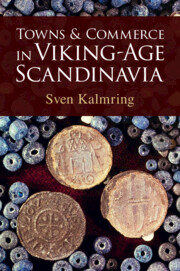Book contents
- Towns and Commerce in Viking-Age Scandinavia
- Additional material
- Towns and Commerce in Viking-Age Scandinavia
- Copyright page
- Epigraph
- Contents
- Plates
- Figures
- Maps
- Acknowledgements
- Abbreviations
- Maps
- 1 Introduction
- 2 The Viking-Age Town
- 3 The Viking World
- 4 Cult, Jurisdiction and Markets
- 5 Local Society and Viking-Age Towns
- 6 An Urbanisation Based on Harbours
- 7 Jurisdiction and Taxes
- 8 Free Trade within Narrow Boundaries
- 9 Special Economic Zones of Their Time
- 10 Development after the Inception Phase
- 11 Discussion: Hedeby’s Abandonment and the Foundation of Slesvig
- 12 Summary and Conclusions
- References
- Index
- Plate Section
11 - Discussion: Hedeby’s Abandonment and the Foundation of Slesvig
Published online by Cambridge University Press: 04 January 2024
- Towns and Commerce in Viking-Age Scandinavia
- Additional material
- Towns and Commerce in Viking-Age Scandinavia
- Copyright page
- Epigraph
- Contents
- Plates
- Figures
- Maps
- Acknowledgements
- Abbreviations
- Maps
- 1 Introduction
- 2 The Viking-Age Town
- 3 The Viking World
- 4 Cult, Jurisdiction and Markets
- 5 Local Society and Viking-Age Towns
- 6 An Urbanisation Based on Harbours
- 7 Jurisdiction and Taxes
- 8 Free Trade within Narrow Boundaries
- 9 Special Economic Zones of Their Time
- 10 Development after the Inception Phase
- 11 Discussion: Hedeby’s Abandonment and the Foundation of Slesvig
- 12 Summary and Conclusions
- References
- Index
- Plate Section
Summary
Finally, one might ask why Hedeby, after such a successful transformation as described in the previous chapter, which enabled the town to persist well into the eleventh century, was abandoned after all and finally relocated to present-day Slesvig. Despite comparable topographical conditions – just as Hedeby was located by the Haddeby Noor, Slesvig emerged by the (today silted) Holmer Noor – it is striking that the old town of Slesvig, which was delimited by its 12-hectare pocket-shaped peninsula on the northern shore of the inner Schlei fjord, was in fact only half the size of the urban area of Hedeby. Previously, three partly interdependent main hypotheses for the shift from Viking-age Hedeby to high medieval Slesvig had been put forward: (1) two subsequent devastating attacks in 1050 and 1066 recorded in the written sources; (2) the spatial integration of economical, administrational, and ecclesiastical functions, together with the assumption that the latter two already pre-existed at Slesvig and constituted a pull factor within a ‘second wave of urbanisation’; and (3) the assumed preceding economic decline of Hedeby as an emporium, which had already commenced in the late tenth century (cf. Hilberg 2007: 189–90; 2016).
- Type
- Chapter
- Information
- Towns and Commerce in Viking-Age Scandinavia , pp. 187 - 195Publisher: Cambridge University PressPrint publication year: 2024



